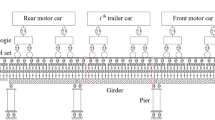Abstract
Earthquake is a kind of sudden and destructive random excitation in nature. It is significant to determine the probability distribution characteristics of the corresponding dynamic indicators to ensure the safety and the stability of structures when the intensive seismic excitation, the intensity of which is larger than 7, acts in train-bridge system. Firstly, the motion equations of a two-dimensional train-bridge system under the vertical random excitation of track irregularity and the vertical seismic acceleration are established, where the train subsystem is composed of 8 mutually independent vehicle elements with 48 degrees of freedom, while the single-span simple supported bridge subsystem is composed of 10 2D beam elements with 20 degrees of freedom on beam and 2 large mass degrees of freedom at the support. Secondly, Monte Carlo method and pseudo excitation method are adopted to analyze the statistical parameters of the system. The power spectrum density of random excitation is used to define a series of non-stationary pseudo excitation in pseudo excitation method and the trigonometric series of random vibration history samples in Monte Carlo method, respectively solved by precise integral method and Newmark-β method through the inter-system iterative procedure. Finally, the results are compared with the case under the weak seismic excitation, and show that the samples of vertical acceleration response of bridge and the offload factor of train obeys the normal distribution. In a high probability, the intensive earthquakes pose a greater threat to the safety and stability of bridges and trains than the weak ones.
摘要
地震荷载是自然界中一种突发并且对结构具有一定破坏性的随机激励。当震级大于6级即地震 烈度在7 以上的地震即**震作用在车桥耦合系统中时,确定系统响应的概率分布特性用于保障行车和 结构安全稳定十分重要。因此,本文分别采用蒙特卡洛实验法以及虚拟激励随机振动分析方法,构建 二维车桥耦合系统空间状态方程,考虑轨道不**顺随机激励和确定性轴重激励,以及通过大质量法输 入地震随机激励,借助精细积分法通过全过程迭代过程对该状态方程进行精确高效求解响应时程分 布。由此确定系统响应及相应动力学指标的概率分布,与非**震条件下的响应概率分布特性对比,最 终为保障行车和桥梁结构安全稳定提供建议。
Similar content being viewed by others
Reference
O’PEILLY G J. Seismic intensity measures for risk assessment of bridges [J]. Bulletin of Earthquake Engineering, 2021, 19(9): 3671–3699. DOI: https://doi.org/10.1007/s10518-021-01114-z.
YAU J D, FRÝBA L. Response of suspended beams due to moving loads and vertical seismic ground excitations [J]. Engineering Structures, 2007, 29(12): 3255–3262. DOI: https://doi.org/10.1016/j.engstruct.2007.10.001.
YAU J D. Dynamic response analysis of suspended beams subjected to moving vehicles and multiple support excitations [J]. Journal of Sound and Vibration, 2009, 325(4–5): 907–922. DOI: https://doi.org/10.1016/j.jsv.2009.04.013.
NISHIMURA K, TERUMICHI Y, MORIMURA T, et al. Experimental study on the vehicle safety by earthquake track excitation with 1/10 scale vehicle and roller rig [J]. Journal of System Design and Dynamics, 2010, 4(1): 226–238. DOI: https://doi.org/10.1299/jsdd.4.226.
NISHIMURA K, TERUMICHI Y, MORIMURA T, et al. Analytical study on the safety of high speed railway vehicle on excited tracks [J]. Journal of System Design and Dynamics, 2010, 4(1): 211–225. DOI: https://doi.org/10.1299/jsdd.4.211.
HE **ng-wen, KAWATANI M, HAYASHIKAWA T, et al. Numerical analysis on seismic response of Shinkansen bridge-train interaction system under moderate earthquakes [J]. Earthquake Engineering and Engineering Vibration, 2011, 10(1): 85–97. DOI: https://doi.org/10.1007/s11803-011-0049-1.
LOH C H, LEE Zheng-kuan. Seismic monitoring of a bridge: Assessing dynamic characteristics from both weak and strong ground excitations [J]. Earthquake Engineering & Structural Dynamics, 1997, 26(2): 269–288. DOI: https://doi.org/10.1002/(SICI)1096-9845(199702)26:2<269:AID-EQE644>3.0.CO;2-H.
QI **g-**g, JIANG Li-zhong. Experimental study on seismic behaviors of steel-concrete composite frames [J]. Journal of Central South University, 2015, 22(11): 4396–4413. DOI: https://doi.org/10.1007/s11771-015-2988-6.
ZHU Zhi-hui, GONG Wei, WANG Kun, et al. Dynamic effect of heavy-haul train on seismic response of railway cable-stayed bridge [J]. Journal of Central South University, 2020, 27(7): 1939–1955. DOI: https://doi.org/10.1007/s11771-020-4421-z.
LIN Jia-hao, ZHANG Wen-shou, WILLIAMS F W. Pseudoexcitation algorithm for nonstationary random seismic responses [J]. Engineering Structures, 1994, 16(4): 270–276. DOI: https://doi.org/10.1016/0141-0296(94)90067-1.
ZHANG Z C, LIN J H, ZHANG Y H, et al. Nonstationary random vibration analysis of coupled vehicle-bridge systems [J]. Engineering Computations, 2010, 27(6): 712–732. DOI: https://doi.org/10.1108/02644401011062108.
HE Xu-hui, SHI Kang, WU Teng. An efficient analysis framework for high-speed train-bridge coupled vibration under non-stationary winds [J]. Structure and Infrastructure Engineering, 2020, 16(9): 1326–1346. DOI: https://doi.org/10.1080/15732479.2019.1704800.
ZHU Si-yu, LI Yong-le. Random characteristics of vehicle-bridge system vibration by an optimized pseudo excitation method [J]. International Journal of Structural Stability and Dynamics, 2020, 20(5): 2050069. DOI: https://doi.org/10.1142/s0219455420500698.
YU He-lu, WANG Bin, XIA Cui-peng, et al. Efficient non-stationary random vibration analysis of vehicle-bridge system based on an improved explicit time-domain method [J]. Engineering Structures, 2021, 231: 111786. DOI: https://doi.org/10.1016/j.engstruct.2020.111786.
XIA He, ZHANG Nan, GUO Wei-wei. Dynamic interaction of train-bridge systems in high-speed railways [M]. Berlin, Heidelberg: Springer Berlin Heidelberg, 2018. DOI: https://doi.org/10.1007/978-3-662-54871-4.
BATHE K J. Finite element procedures [M]. Prentice Hall, Pearson Education, Inc, 2006.
ARGENTINI T, PAGANI A, ROCCHI D, et al. Monte Carlo analysis of total dam** and flutter speed of a long span bridge: Effects of structural and aerodynamic uncertainties [J]. Journal of Wind Engineering and Industrial Aerodynamics, 2014, 128: 90–104. DOI: https://doi.org/10.1016/j.jweia.2014.02.010.
BOGDANOFF J L, GOLDBERG J E, BERNARD M C. Response of a simple structure to a random earthquake-type disturbance [J]. Bulletin of the Seismological Society of America, 1961, 51(2): 293–310. DOI: https://doi.org/10.1785/bssa0510020293.
LIN J H, ZHANG Y H, LI Q S, et al. Seismic spatial effects for long-span bridges, using the pseudo excitation method [J]. Engineering Structures, 2004, 26(9): 1207–1216. DOI: https://doi.org/10.1016/j.engstruct.2004.03.019.
ZHONG Wan-xie, CAI Zhi-qin. Precise integration method for LQG optimal measurement feedback control problem [J]. Applied Mathematics and Mechanics, 2000, 21(12): 1417–1422. DOI: https://doi.org/10.1007/BF02459220.
TB10621—2014. Code for design of high-speed railway [S]. China Railway Publishing House. (in Chinese)
ZHANG Nan, XIA He. A vehicle-bridge interaction dynamic system analysis method based on inter-system iteration [J]. China Railway Science, 2013, 34(5): 32–38. (in Chinese)
HOROVÁ I, KOLÁČEK J, ZELINKA J. Kernel smoothing in Matlab [M]. Singapore: World Scientific, 2012. DOI: https://doi.org/10.1142/8468.
ZGHOUL A A. A goodness of fit test for normality based on the empirical moment generating function [J]. Communications in Statistics-Simulation and Computation, 2010, 39(6): 1292–1304. DOI: https://doi.org/10.1080/03610918.2010.490318.
ROFOOEI F R, MOBARAKE A, AHMADI G. Generation of artificial earthquake records with a nonstationary Kanai-Tajimi model [J]. Engineering Structures, 2001, 23(7): 827–837. DOI: https://doi.org/10.1016/S0141-0296(00)00093-6.
XIANG Jun, LI De-jian, ZENG Qing-yuan. Simulation of spatially coupling dynamic response of train-track time-variant system [J]. Journal of Central South University of Technology, 2003, 10(3): 226–230. DOI: https://doi.org/10.1007/s11771-003-0014-x.
LIU Chi, THOMPSON D, GRIFFIN M J, et al. Effect of train speed and track geometry on the ride comfort in highspeed railways based on ISO 2631-1 [J]. Proceedings of the Institution of Mechanical Engineers, Part F: Journal of Rail and Rapid Transit, 2020, 234(7): 765–778. DOI: https://doi.org/10.1177/0954409719868050.
Author information
Authors and Affiliations
Contributions
WU Zhao-zhi came up with the concept, realized the simulation, analyzed the data and edited the draft of manuscript. ZHANG Nan conducted the literature review, checked the computations, wrote the draft of the manuscript replied to reviewers’ comments and revised the final version.
Corresponding author
Additional information
Conflict of interest
The authors declare that they have no known competing financial interests or personal relationships that could have appeared to influence the work reported in this paper.
Foundation item: Project(52178101) supported by the National Natural Science Foundation of China
Rights and permissions
About this article
Cite this article
Wu, Zz., Zhang, N. Response of train-bridge system under intensive seismic excitation by random vibration method. J. Cent. South Univ. 29, 2467–2484 (2022). https://doi.org/10.1007/s11771-022-5106-6
Received:
Accepted:
Published:
Issue Date:
DOI: https://doi.org/10.1007/s11771-022-5106-6
Key words
- random vibration method
- intensive seismic excitation
- train-bridge system
- probability distribution
- intersystem iteration
- precise integral method




